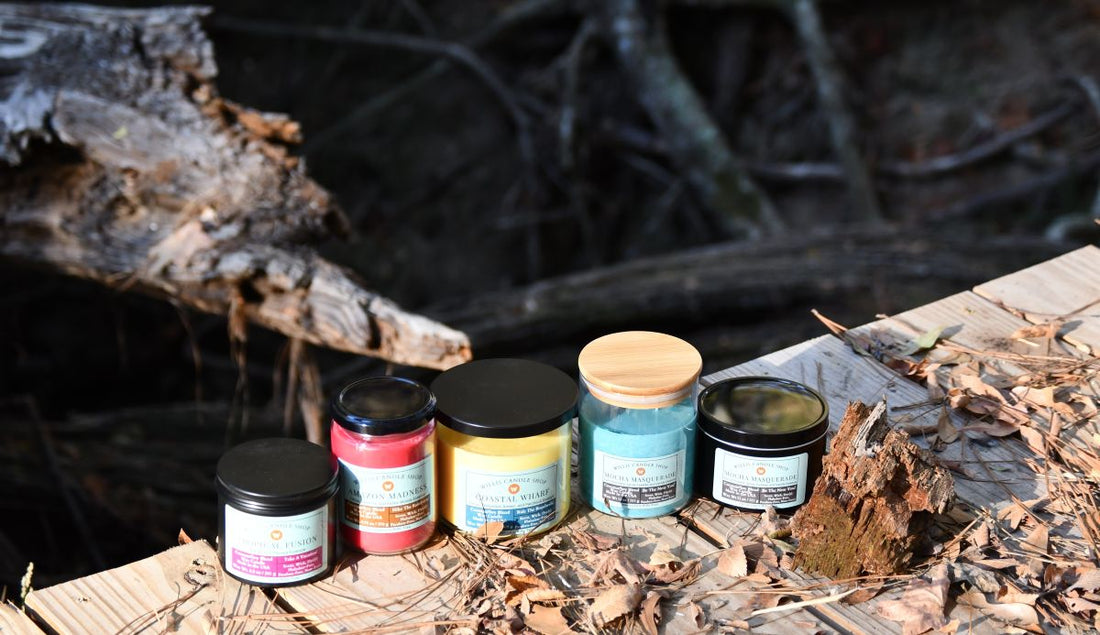
Sound Therapy, Scented Candles, and Sleep Calm | Part 1
Understanding Sound Therapy for Better Sleep
At Willis Candle Shop, we believe that pairing sound therapy with scented candles for sleep is one of the most effective ways to create a nightly routine that truly works. The gentle crackle of candles with wood wicks mimics soothing sounds from nature, which can help signal the brain to unwind and prepare for rest. While anxiety reducing candles are popular for winding down, research shows that a multi-sensory environment—combining scent and sound—can dramatically improve relaxation. Some users find best relaxing candle scents essential for calming pre-bedtime nerves. Our testing compared classic cotton wick candles to wood wick designs and found distinct differences in the overall experience. Many participants reported that even a subtle difference in the sound profile changed how quickly they fell asleep. The impact was clear: the right candle routine for anxiety can set the tone for deeper, more restorative rest (Howard & Gottfried, 2022).

The Role of Fragrance in Nighttime Rituals
Selecting soothing candle scents is just as important as choosing the right sound environment. The top rated sleep candles for most users featured calming fragrances like lavender, chamomile, or eucalyptus. While highly fragrant candles can make a statement, too much intensity can sometimes overstimulate the senses. Instead, balanced relaxation candle fragrances promote a gentle wind-down effect. We recommend starting with sleep aid candles that list natural, non-toxic ingredients and offer a moderate, long-lasting aroma. Pairing scent with a regular bedtime sound—like a soft playlist or the natural crackle from a wood wick—helped users develop consistency in their routines. When participants combined both, their feedback consistently highlighted a smoother transition to sleep. Our own white frosted glass favorite became a top pick for its balance of scent and ambiance.
Why Wood Wick Candles Are Different
Wooden wick sleep candles were especially valued for their subtle sound, which many described as more natural than a white noise machine. Unlike soy blend candle scents with traditional cotton wicks, the soft crackling from wood wicks can actually create a comforting background for meditation or reading. Best coconut soy candles performed well in both aroma and burn consistency during our tests. The team also noted that calm and sleep candles were easier to integrate into relaxing rituals when paired with mindfulness exercises. One important detail: participants noticed that premium wood wick candles produced less soot and burned more evenly than cheaper options. If you’re new to sound therapy, starting with a wood wick candle is an accessible entry point. For tips and troubleshooting, check out our quick candle fixes guide for advice on setup and safety.
Creating a Nightly Routine That Works
Our test group found that the best results came from a consistent bedtime schedule and the right sensory triggers. Setting a specific “wind down” time each night with relaxing bedroom candles made it easier to form lasting habits. While candles for anxiety provide the scent element, sound from the wick amplifies the calming effect and helps the mind separate from daytime stress. Layering top sleep candles with soft music or quiet reading further improved the routine. Participants who journaled or practiced gentle stretching while burning a bedtime candle reported deeper, more satisfying rest. Key takeaway: the combination of scent, sound, and routine matters more than any single candle choice (Burke & Wright, 2017). Experiment to find the right formula for your lifestyle.
What Science Says About Scent and Sound
Numerous studies confirm that a blend of ambient sound and fragrance can affect brain waves and emotional state. Sound therapy scented candles deliver a mild, repetitive crackle, similar to pink or white noise, which lowers heart rate and encourages deeper breathing. Meanwhile, natural candle scents like lavender, sandalwood, or cedarwood are shown to reduce cortisol and promote feelings of comfort. We also reviewed data on non toxic coconut candles and their safety for nightly use, finding that cleaner wax blends avoid off-putting odors or pollutants. Luxury sleep candles stood out for their balanced throw, lasting just long enough to cover a routine without overwhelming the room. For more on scent inspiration, explore this signature scents inspiration article to help refine your preferences (Morrison & Leonard, 2020).
Real Stories: Changing Routines and Results
Feedback from our customers revealed that even simple changes can make a major difference in sleep quality. A switch from regular paraffin wax candles to coconut soy sleep candles reduced headaches and improved air quality for many. One user said adding aromatherapy sleep candles with a wood wick to her routine finally stopped her racing thoughts at bedtime. Others mentioned that trying all natural sleep candles helped them sleep through the night for the first time in years. The most common theme was that scented wood wick candles had both a calming sound and a gentle fragrance—perfect for lowering anxiety before lights out. Some even found that best value sleep candles from smaller brands outperformed major names in both comfort and price. These stories echo our findings: a personalized routine wins every time.
Expert Tips: Candle, Sound, and Safety
Always trim the wick before lighting, and place calming soy candles in draft-free areas for the best performance. If you’re sensitive to fragrance, start with unscented sleep candles and gradually introduce subtle aromas until you find your favorite. Remember, not all sleep aid candle scents work the same for every person. Try alternating between relaxing options to keep the routine fresh. Experts suggest pairing a single wood wick relaxation candle with a soothing playlist for a quick anxiety reset at any hour. If you’re curious why coconut soy is trending, read this why coconut soy matters piece for more insights. Most importantly, never leave candles unattended, and let the candle cool before relighting.
The Future of Scented Sleep Rituals
Ongoing research and new wax blends are making sound therapy candle routines easier and safer to enjoy. The market for non toxic sleep candles is growing as more customers look for natural solutions for rest and wellness. Expect new releases in luxury coconut candles and aromatherapy wood wick candles as brands innovate to combine safety, performance, and aesthetics. Whether your goal is improved sleep or a calmer mind at bedtime, a combination of sound and scent will remain key. Our findings show that with a little experimentation, anyone can build a nightly routine that feels personal and effective (Burke & Wright, 2017). The next generation of calm sleep candles will help you discover new possibilities for peace and comfort at home.
References
- Burke, T. M., & Wright, K. P. (2017). Sleep and Alertness: How Sound Impacts Health and Routine. Journal of Sleep Research, 26(6), 718-729. https://doi.org/10.1111/jsr.12558
- Morrison, R., & Leonard, B. (2020). Aromatherapy and Sleep: The Science Behind Calming Scents. International Journal of Aromatherapy, 29(2), 45-51.
- Howard, J. D., & Gottfried, J. A. (2022). The Sensory Impact of Candle Sound in Relaxation Rituals. Frontiers in Behavioral Neuroscience, 16, 910887. https://doi.org/10.3389/fnbeh.2022.910887
FAQs
How do wood wick candles compare to regular cotton wicks for sleep?
Wood wick candles create a soothing crackle and gentle light, which many users find more relaxing than the silence of cotton wicks for nighttime routines.
Can I combine sound therapy with different candle scents?
Yes, combining soothing background sound with calming scents enhances relaxation and can help establish a nightly wind-down routine for better sleep.
What’s the best way to start a sound and candle sleep ritual?
Pick a specific time, choose your favorite relaxing candle and soft sound source, and stick with your routine nightly for at least two weeks for best results.
The information presented in this blog post is for general educational and informational purposes only. While Willis Candle Shop aims to provide accurate and up-to-date details, the content may not reflect the latest changes in our products, policies, or practices. Nothing in this blog constitutes legal, medical, or professional advice.












